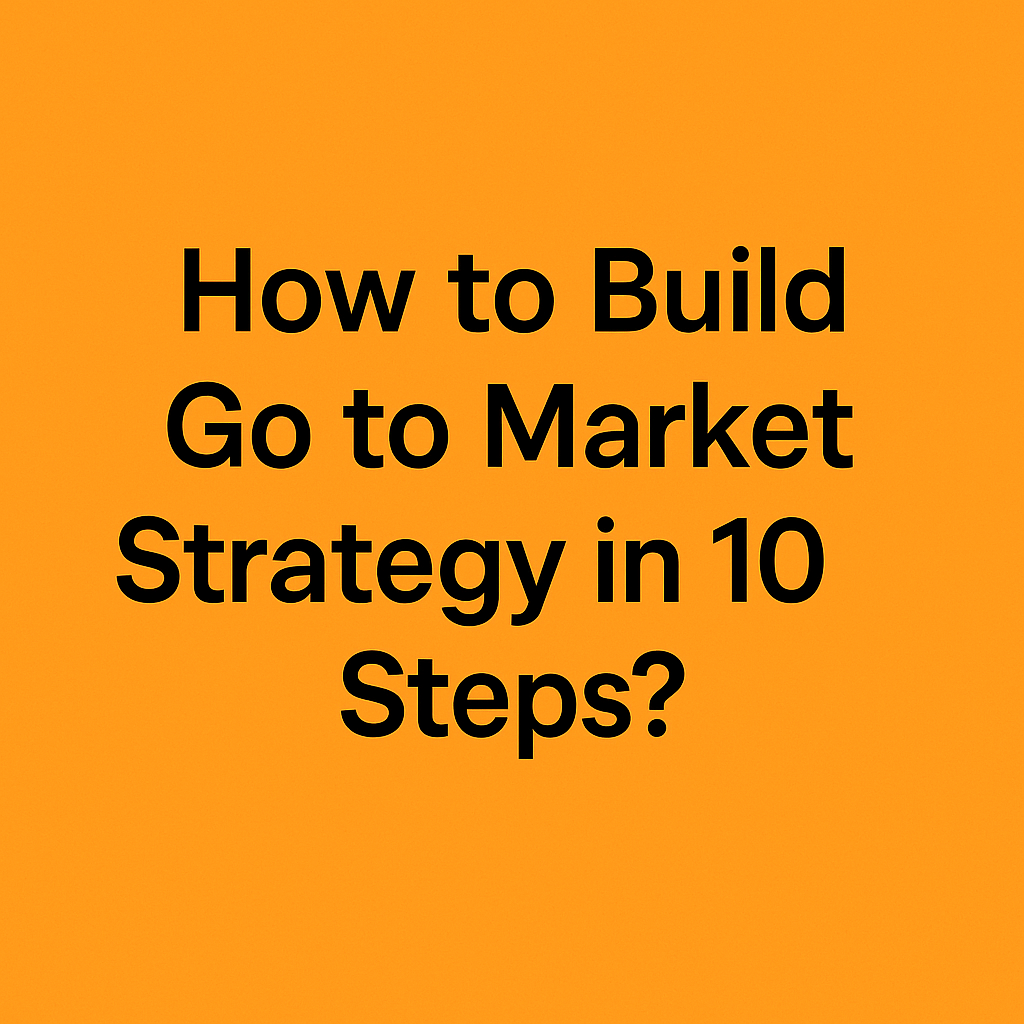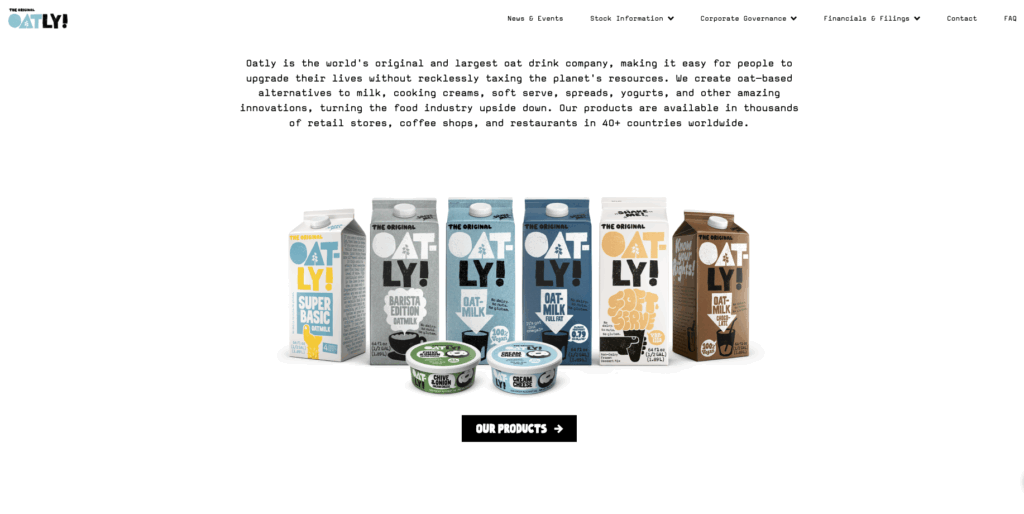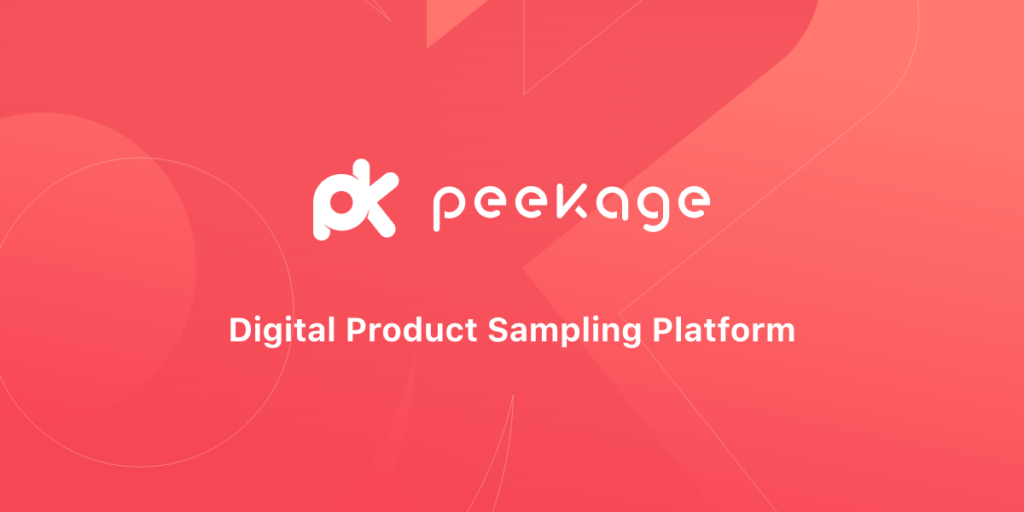Launching a new product is like preparing for battle; without a clear game plan, you risk chaos, confusion, and costly mistakes. That's where a go-to-market strategy comes in. This comprehensive guide breaks down what a go-to-market strategy is, how to build one that wins and includes real-world examples to inspire your approach.
Expanding your business without a clear go-to-market strategy is like setting sail without a compass. Whether you're a scrappy startup or a scaling SaaS company, the go-to-market strategy acts as your north star. It ensures alignment across teams, maximizes marketing ROI, and accelerates your path to revenue. In this guide, we'll take a deep dive into the go-to-market strategy meaning, when to use one, and exactly how to build a go-to-market strategy from scratch, complete with real-life go-to-market strategy examples, actionable templates, and proven frameworks.
What Is a Go to Market Strategy?
A go-to-market strategy (GTM strategy) is a tactical action plan that outlines how a company will sell its product or service to customers. It aligns your teams, defines your market, and gives you a clear roadmap to generate demand and drive sales, just like in these comprehensive product marketing strategies.
Go-To-Market Strategy Meaning
Simply put, it's your blueprint for bringing a product to market successfully. Whether you're a startup or a global enterprise, having a GTM plan ensures your offering reaches the right audience with the right message at the right time.
"A well-crafted go-to-market strategy reduces guesswork and maximizes your product's chances of success."
Importance of a Go-To-Market Strategy
- Minimizes risk in new product launches
- Aligns marketing, sales, and product teams
- Accelerates time-to-market
- Optimizes budget and resources
- Enables repeatable and scalable growth
- Clarifies roles and responsibilities
- Improves investor confidence
GTM strategies are not only for new product launches; they're also critical for expanding into new markets, entering different geographies, or even when shifting brand positioning. Companies with strong GTM execution outperform competitors in product adoption and customer retention.
When Do You Need a Go-To-Market Strategy?
Not every product or initiative needs a full-blown GTM plan, but in key scenarios, it's non-negotiable. Here are common situations where you should build a go-to-market strategy:
Scenarios Requiring a Strategy Go to Market
- Launching a new product in an existing market
Example: Apple launching AirPods. They built anticipation through existing brand channels and created demand via sleek product teasers and retail integration. - Entering a new market with an existing product
Example: Netflix expanding into India. They localized pricing, content, and marketing to capture a culturally distinct and price-sensitive market. - Launching a new feature that needs to drive user engagement or revenue
Example: LinkedIn's introduction of Stories. They promoted it via email marketing and in-app onboarding tutorials to boost early engagement. - Pivoting your business model or targeting a new customer segment
Example: Shopify pivoting from e-commerce tools to a full-scale retail operating system for brick-and-mortar businesses. - Introducing a product category that requires customer education
Example: Peloton launching connected fitness. They invested in video content, influencer demos, and educational webinars to explain the new concept. - Testing pricing or distribution changes in pilot markets
Example: Uber testing UberPool in select cities before a global rollout, analyzing pricing sensitivity and operational feasibility.
Core Components of a Go-To-Market Strategy
A successful go to market strategy is built on several foundational pillars. Here's a detailed breakdown of each, why it matters, and how it helps you win in your market:
| Component | What It Is | Why It Matters |
| Market Definition | Understanding the industry, size, growth, trends, and competition. | Helps validate demand, identify positioning opportunities, and estimate market potential. |
| Customer Segmentation | Dividing your market into distinct groups with shared characteristics. | Enables targeted messaging, personalized experiences, and efficient use of resources. |
| Value Proposition | The clear statement of what makes your product worth buying. | Differentiates your offering and drives emotional and rational buying decisions. |
| Distribution Model | The methods by which customers will access and buy your product. | Influences cost, scalability, reach, and user experience. |
| Marketing and Sales Strategy | The channels, content, and actions used to attract and convert buyers. | Generates leads, nurtures prospects, and closes deals effectively. |
| Pricing Strategy | How you price your product to reflect value, market norms, and goals. | Impacts revenue, perception, and adoption across segments. |
Quick Note: This section covers the essential elements that make up any go-to-market strategy, what you need to build. Think of these as the 'ingredients' for your go to market strategy plan. In the next section, we'll walk through the exact steps to combine and activate these components in the real world.
- Market Definition: Identifying target markets and understanding their needs.
- Customer Segmentation: Defining the ideal customer profile and buyer personas.
- Value Proposition: Clarifying the unique value the product offers to the target audience.
- Distribution Model: Deciding how the product will be delivered to customers.
- Marketing and Sales Strategy: Planning promotional tactics and sales approaches.
- Pricing Strategy: Determining the product's pricing to match market expectations and value.
How to Build Go to Market Strategy in 10 Steps?

Creating a go-to-market strategy doesn't have to be overwhelming. Here's a steps in go to market strategy that help you craft a powerful go to market strategy plan that aligns with your goals and customers' needs.
Step 1: Identify the Problem
This is the foundation of your entire go-to-market strategy. Before you can market or sell anything effectively, you must be crystal clear about the exact problem your product solves. If your customers don't feel like you understand their pain, they won't believe you can fix it.
To identify the real problem:
- Talk directly to your potential customers: Ask them what frustrates them, what takes up too much time, or what they wish existed.
- Analyze your current support tickets or feedback: Look for repeated complaints or recurring pain points.
- Watch your competitors: What are their customers complaining about in reviews or forums? What gaps can you fill?
Read More: Concept Testing: The Key to Launching Products Your Customers Actually Want
Understanding the problem from your customer's perspective allows you to create messaging that resonates and ensures your product truly solves a meaningful need.
Example: If you're creating a budgeting app for college students, the problem might not be "students need to budget better." It might be: "Students feel overwhelmed by their finances and don't know where to start."
Step 2: Define the Target Market
Before you start marketing, you need to clearly understand who your product is really for. Defining your target market means identifying the specific group of people or businesses who are most likely to benefit from and buy your solution.
Think of it like this: instead of trying to sell to "everyone," you focus your energy on the right group of people,the ones who actually need what you're offering. Not everyone is your customer. by narrowing your focus, you can communicate more clearly and convert more effectively.
Here's how you break it down:
- Demographics: Think about age, gender, location, education, and income. These factors often influence buying habits. If you sell to individuals (B2C), look at age, gender, income, location, and interests. For example, college students might need budget-friendly tools, while senior professionals may value premium features.
- Firmographics (for B2B): These include company size, industry, annual revenue, and geographic location. A small startup and a large enterprise will have very different needs and budgets. If you sell to businesses (B2B), focus on company size, industry, location, and revenue.
- Behavior: Look at how customers interact with your product. What problems are they trying to solve? What makes them buy? What do they do before purchasing?
- Find your strongest niche: Where does your product bring the most value? Who gets the best results? Start there instead of going broad.
- Use tools and research: Google Trends, industry reports, and customer surveys can help you spot demand, preferences, and behavior patterns.
Example: Instead of saying "we serve small businesses," a clearer target market would be: "online boutique owners in the U.S. making $100K - $500K annually who struggle with managing inventory and shipping."
Defining your target market helps you craft better messaging, design more effective campaigns, and close more sales.
Read More: Top Consumer Insights Examples: How They Can Transform Your Business
Step 3: Develop Buyer Personas
Buyer personas are fictional, yet realistic profiles that represent your ideal customers. They help you understand the people you're trying to sell to, not just as statistics or titles, but as real humans with goals, frustrations, and decision-making patterns.
To create effective personas, start by gathering insights from real users:
- Include personal background: job title, industry, company size, age, experience level
- Identify goals: What does this person want to achieve at work or in life?
- Understand challenges: What's standing in their way? What frustrates them?
- Know their behavior: Where do they go for information? Do they prefer emails, social media, or in-person demos?
Involve your sales and support teams, they're on the front lines and know your real customers best. Use interview notes, CRM data, and support conversations to shape your personas.
Once segmented, define:
Ideal Customer Profile (ICP): This is your dream customer. It's the business or person who's the perfect fit for your product. They get the most value from it and are easiest to acquire and retain.
Buyer Personas: These are semi-fictional characters that represent different types of buyers. You give them names, job titles, goals, pain points, and buying motivations. This helps you talk to them like real people.
Example: Imagine you're selling a simple task management app. One segment could be freelance creatives (your ICP), and you create a persona like "Olivia, a freelance graphic designer who struggles to track multiple client deadlines and wants a mobile-friendly tool that integrates with Google Calendar."
Example: A B2B SaaS platform might segment by company size and target tech-savvy operations managers at fast-growing startups.
Example: For a small business accounting tool, you might create a persona like "Anna, a 38-year-old bakery owner who's great at baking but stressed about taxes. She checks her email in the morning and reads articles on her phone between customer visits."
The clearer your personas, the easier it is to tailor your messaging, product design, and sales approach.
Step 4: Craft the Value Proposition
Your value proposition is the heart of your offer. It answers the question: Why should someone choose your product over any other? Before scaling, make sure to test and refine your positioning and messaging. It's more than just listing features, it's about making your audience feel seen, heard, and confident that your solution is right for them.
To create a strong value proposition:
- Focus on benefits, not just what your product does. What positive change does it bring?
- Highlight both emotional (simplicity, trust, empowerment) and rational (saves money, improves speed, increases revenue) appeals.
- Keep it short, clear, and direct. Avoid jargon. Speak like your customer.
- Make it specific to each buyer persona. One-size-fits-all messages usually fit no one.
Simple Example: If you're selling an app that organizes family chores, a clear value proposition might be:
"We help busy parents bring order to household chaos by making chore management easy and fun for kids."
Business Example: "We help small e-commerce store owners save time and reduce order errors by automating their shipping and inventory management in one easy-to-use dashboard.
Step 5: Choose a Marketing Strategy
This section of your go-to-market strategy is about how you plan to attract potential customers, build trust with them, and ultimately convince them to buy.
Think of it like this: marketing brings people to your door, and sales helps them walk through it.
Your plan should cover the three major stages of the customer journey:
- Top of Funnel (Awareness): This is where people first learn about your brand or product. Use strategies like blog posts, social media content, SEO, paid ads, and PR to get on your audience's radar.
- Middle of Funnel (Consideration): Once people know you exist, they need more info before they trust you. Provide webinars, email nurture sequences, comparison guides, testimonials, and demos to educate and build confidence.
- Bottom of Funnel (Decision): Here's where they're ready to act. Encourage sign-ups or purchases with free trials, discounts, one-on-one sales calls, or personalized offers.
You should also decide how to balance:
- Inbound: People come to you (e.g., SEO, referrals, organic content)
- Outbound: You reach out to them (e.g., cold emails, direct sales, advertising)
Example: Imagine a time management app for freelancers. The team might run blog content and YouTube videos for awareness (top), send email tips and case studies for trust-building (middle), and finally offer a 14-day free trial to convert warm leads (bottom).
Example: If you're launching a new online course platform, your strategy might include:
- Writing SEO-optimized blog posts about course creation
- Running YouTube ads targeting educators
- Using influencer testimonials to build credibility
- Sending a weekly email series with free tips to nurture leads
Read More: Demand Generation Strategies for CPG Brands
Step 6: Plan the Sales Strategy
Your sales strategy is how you'll turn interested prospects into paying customers. It's more than just having a sales team,it's about creating a consistent, repeatable, and customer-friendly process that supports every stage of the buying journey.
Here's how to plan it:
- Define Sales Roles: Assign clear responsibilities. SDRs (Sales Development Reps) handle initial outreach and lead qualification, AEs (Account Executives) close deals, and CSMs (Customer Success Managers) focus on retention and upselling.
- Set Up a CRM: A Customer Relationship Management tool (like HubSpot or Salesforce) keeps track of your leads, follow-ups, deal stages, and performance metrics in one place.
- Create Sales Assets: Build resources that help your team sell better, like email scripts, call guides, objection-handling sheets, and sales playbooks.
Example: A startup selling a B2B productivity tool might assign an SDR to cold email qualified leads, an AE to conduct demos and negotiate deals, and a CSM to ensure smooth onboarding and long-term usage.
A good sales strategy isn't pushy,it's structured, helpful, and aligned with how your ideal customer wants to buy.
Step 7: Set Pricing
Your pricing strategy is one of the most important parts of your go-to-market plan,it directly affects how your product is perceived, how accessible it is to your market, and how profitable your business can be.
Your pricing strategy defines how much you charge for your product and how that price creates value for your customers while also helping your business grow. Good pricing should feel fair to the customer and sustainable for you.
Let's simplify the most common pricing models:
- Freemium: Offer a basic version for free, and charge for advanced features. This is great for building user base quickly (especially in SaaS). Think of it like giving a free sample,once they're hooked, they'll pay for more.
- Tiered Pricing: You create different packages (e.g., Basic, Pro, Enterprise) for different user needs. This works well when you serve a range of customers from small startups to large companies.
- Usage-Based: Also called "pay-as-you-go," customers are charged based on how much they use (e.g., storage, data, API calls). This is common in cloud services and infrastructure tools.
- Flat-Rate: One simple price for everyone. It's easy to understand and sell, especially for smaller products or early-stage startups.
Example: AWS uses usage-based pricing, charging users only for the computing power or storage they use. Dropbox uses a freemium model,users get free storage and can pay for more advanced features.
How to decide on pricing:
- Understand your value: What are people really paying for? Time savings? Peace of mind?
- Study your competitors: What do similar products charge?
- Know your costs: Don't price below what it costs to deliver the product.
- Test and adapt: Run pricing tests with small groups before launching company-wide.
- Use psychology: Rounded pricing (e.g., $49 vs $50), bundles, and anchor pricing (showing a higher price first) all influence buyer decisions.
Pro Tip: Pricing isn't one-and-done. It evolves with your product, your audience, and the market. Review it regularly.
Step 8: Select Distribution Channels
Your distribution channels are the pathways that connect your product to your customers. Choosing the right channel depends on your product type, the preferences of your target market, and your resources.
Ask yourself: Where do my ideal customers expect to buy or experience my product?
Here are some common options explained:
| Channel | Use Case | Example |
| Direct Sales | Ideal for high-ticket or complex products where education or negotiation is needed. Your team handles everything directly with the buyer. | Salesforce |
| Online Self-Serve | Perfect for digital or low-cost products where customers prefer to explore and buy on their own without speaking to sales. | Canva |
| Partners/VARs | Works well in specific industries or geographies where local knowledge, relationships, or added services help close the sale. | Cisco |
Example: If you're launching a new project management tool for small businesses, you might start with an online self-serve model so customers can sign up directly on your website. As you grow, you might also add channel partners who serve niche industries like construction or healthcare.
Step 9: Measure and Optimize
Creating your GTM strategy is just the beginning; tracking performance and improving continuously is where the real success happens. This step is about making sure your strategy is actually working and knowing what to change if it isn't.
Here's what to focus on:
- CAC (Customer Acquisition Cost): How much are you spending to acquire each customer? This helps you understand the cost-effectiveness of your sales and marketing.
- LTV (Customer Lifetime Value): How much revenue does a typical customer bring in over their relationship with your business? Comparing LTV to CAC shows if you're acquiring profitable customers.
- Conversion Rates: Measure how leads move through your sales funnel,from first touch to purchase. High drop-off at one stage? That's your bottleneck.
- Feedback Loops: Regularly gather feedback from customers and your team. What are people saying post-purchase? Are they satisfied, confused, or leaving?
Example: If your CAC is $300 but your LTV is only $250, you're losing money on every customer. That's a signal to either increase LTV (e.g., with better onboarding and upselling) or lower your CAC (e.g., by improving ad targeting).
Continuous measurement ensures your GTM strategy evolves with your market, instead of becoming outdated or wasteful.
Read More: 7 Essential Steps to Master Product Testing and Create a Winning Product
Final Step: Put It All Together with a Go-to-Market Strategy Template and Builder
Now that you've learned the steps, it's time to take action. Instead of building your go-to-market strategy template plan from scratch, consider using a GTM strategy builder to streamline your work and align your team:
Try these GTM tools:
- Miro GTM Canvas - Great for visual planning with cross-functional teams
- Airtable GTM Tracker - Perfect for tracking responsibilities, channels, and milestones
- Notion GTM Template - Ideal for startups and product marketers building repeatable frameworks
Choose the one that fits your workflow, and turn your GTM strategy into a clear, actionable launch plan.
Pro Tip: Want to validate your product-market fit faster? Use a consumer insight platform like Peekage to gather real-time feedback from your target audience. Whether you're refining your messaging, testing packaging, or launching a new product, Peekage helps you make data-driven decisions by connecting you directly with real consumers. It's an efficient way to de-risk your go-to-market strategy and accelerate growth.
Go to market strategy framework
A go-to-market strategy framework is a structured model that helps organizations organize, prioritize, and execute the key elements of bringing a product to market. Think of it as the skeleton that holds your GTM strategy together, defining the who, what, where, and how of your launch. Frameworks reduce guesswork, ensure cross-functional alignment, and provide repeatable steps you can use across different product lines or markets.
Choosing the right go-to-market (GTM) strategy framework depends on your product type, target audience, sales cycle, and industry. Below are proven GTM frameworks, how they work, and real-world examples of each:
1. Funnel-Based Go-To-Market Strategy
This is the traditional GTM framework based on moving prospects through a structured marketing and sales funnel. It includes three clear stages:
- Awareness: Introduce your brand to your ideal audience using SEO, content, social media, and PR.
- Consideration: Educate and build trust with leads through nurturing content like webinars, emails, and comparison guides.
- Decision: Drive conversions using demos, free trials, sales calls, or offers to help leads commit.
Example: HubSpot used this funnel model to great effect, offering free blog content for awareness, email drip campaigns for consideration, and live demos plus free CRM tools to close deals.
2. Product-Led Growth (PLG)
In a PLG model, your product does the selling. Users discover, try, and upgrade without heavy reliance on sales teams.
- Offer a freemium version or free trial
- Focus on a great user experience and onboarding
- Let users unlock more value by upgrading organically
Example: Dropbox gave users free storage and rewarded them for referring friends. As users hit storage limits, they naturally upgraded to paid plans.
Best for: SaaS tools, apps, and developer platforms with low friction and viral potential.
3. Sales-Led Go to Market Strategy
This model is centered around human interaction and relationships. It works best for high-ticket or complex products.
- SDRs qualify leads and book meetings
- Account Executives guide buyers through demos and negotiations
- Customer Success teams help onboard and expand relationships
Example: Salesforce relied heavily on outbound sales, in-depth product demos, and long-term enterprise relationships to grow its CRM business.
Best for: Enterprise software, professional services, or regulated industries.
4. Channel-Led Strategy
This framework involves selling through third parties, such as distributors, resellers, or affiliates.
- Ideal for reaching customers you can't access directly
- Useful for companies expanding into new geographies or industries
- Can scale quickly with the right partnerships
Example: Cisco uses value-added resellers (VARs) to provide technical support and local market expertise across regions where it doesn't have a direct sales force.
5. Ecosystem or Platform Go to Market Strategy
This model integrates your product into a broader ecosystem, so it becomes part of the tools or workflows your audience already uses.
- Build integrations and APIs
- Form partnerships with platforms your customers trust
- Add value without asking users to change their habits
Example: Slack grew rapidly by integrating with popular workplace tools like Google Drive, Trello, and Zoom, making itself essential for team productivity.
Benefits of a GTM Strategy
A go-to-market strategy isn't just a launch plan, it's your strategic engine for consistent growth and market relevance. When done right, it doesn't just help you launch products, it helps you launch them smarter, faster, and more profitably.
Deeper Customer Understanding
You don't just guess who your customer is; you know them. You understand their pain points, goals, language, and behaviors, allowing you to craft laser-focused messaging that resonates.
According to a Gartner survey, 85% of organizations say their go-to-market strategy is effective in driving revenue and business objectives. This shows that structured GTM plans don't just speed up learning, they actually help hit real goals.
Faster Learning Loops
A GTM strategy encourages ongoing testing, feedback, and adaptation. It turns launches into learning platforms, helping you iterate quickly and stay ahead of market shifts.
Efficiency at Scale
Instead of spreading resources thin, a GTM strategy helps you double down on what actually works. You allocate budget, people, and tools to the highest-impact tactics based on real data.
Companies with strong alignment between marketing and sales see 24% faster growth and 27% faster profit growth year over year.
Team Alignment and Focus
Marketing, sales, product, and even customer success all work from the same strategic blueprint. This alignment eliminates wasted effort and prevents miscommunication.
However, up to 70% of GTM strategies fail due to misalignment between teams, making internal coordination not just a benefit but a necessity.
Clear Metrics and Visibility
With defined KPIs (e.g., CAC, LTV, funnel performance), teams know exactly what to measure and improve. It turns "hope" into real, trackable progress.
Higher Conversion and Retention Rates
When your product fits the market, and your message is relevant and timely, customers are far more likely to say yes, and stay loyal.
In one case study, SuperOffice increased new business revenue by 34% by aligning sales and marketing under a shared GTM framework.
Common Pitfalls in Go-to-Market Strategy
Even the best strategies can fall apart without the right execution. Here are some of the most common, and costly, mistakes companies make when rolling out a go-to-market strategy, along with tips to avoid them:
- Assuming the Market Wants It: One of the most dangerous assumptions is thinking customers want what you've built without evidence. Always validate demand with real customer interviews, surveys, or a minimum viable product (MVP).
Real-World Tip: Before launching Airbnb, the founders validated demand by renting out air mattresses in their apartment during a conference, and saw real demand before building the platform. - Messaging Mismatch: Your messaging must speak to the actual pain points of your audience. If your value proposition focuses on features instead of benefits or doesn't resonate with your personas, you risk confusion or disinterest.
Fix it by testing messaging early with landing pages or ad copy A/B testing. - Misaligned Departments: A lack of coordination between marketing, product, and sales can lead to mixed messages, missed handoffs, and lost deals. Every department must share the same goals and definitions of success.
According to SuperOffice, companies with aligned sales and marketing teams grow 24% faster and see 27% more profit. - Ignoring Feedback: Post-launch feedback is gold. Customers will tell you what's working and what's not, if you're listening. Not acting on feedback slows growth and can damage retention.
Set up continuous feedback loops using surveys, Net Promoter Score (NPS) scores, and customer support insights to refine your GTM strategy over time.
Real-World Go-to-Market Strategy Examples
Real strategies. Real outcomes. These go-to-market strategy examples show how different Go-to-Market strategies play out in the wild, what worked, what flopped, and what you can learn from each. Use them as a blueprint or a warning sign, depending on your stage and industry.
Oatly's U.S. Expansion

Oatly, the Swedish oat milk company, successfully entered the U.S. market by doing something different: they didn't immediately go to grocery shelves. Instead, they partnered with high-end coffee shops in urban centers like New York and Los Angeles. Baristas became brand ambassadors, introducing Oatly to consumers in a premium, trusted setting. This grassroots strategy created buzz, educated customers about the benefits of oat milk, and built a loyal customer base before retail distribution.
Key GTM Tactic: Influencer-based seeding through local cafés and experiential sampling.
Slack
Slack's go-to-market strategy is a textbook example of product-led growth (PLG). They skipped the traditional sales-heavy approach and let the product speak for itself. Users could sign up for free, instantly start communicating with their teams, and invite others. The more people joined, the more valuable Slack became, leading to viral adoption. Slack also prioritized integrations with tools teams already used (e.g., Google Drive, Trello), embedding itself deeply in existing workflows.
Key GTM Tactic: Free product with built-in virality and workflow integrations to drive expansion.
Want to understand your market fit better? Learn how to measure and improve brand perception before your next GTM launch.
Quibi (Failed GTM Example)
Quibi raised nearly $2 billion to launch a mobile-only short-form video streaming service. But it misunderstood its target audience. While it assumed people wanted premium, episodic content for mobile, most viewers were happy with YouTube, TikTok, or Netflix. Quibi also launched during the early pandemic lockdowns, when fewer people were commuting, the very situation they built their model around. Worse, they did not test demand sufficiently or build community or brand buzz beforehand.
Key GTM Failure: Misaligned product-market fit, limited distribution model, poor timing, and lack of user testing before launch.
Quick Comparison: Go-to-Market Strategy Success vs. Failure
| Company | Types of Go to Market Strategy | Outcome | Key Lesson |
| Oatly | Influencer Seeding | Success | Build buzz through niche advocates before scale |
| Slack | Product-Led Growth | Success | Make the product the hero with viral adoption |
| Quibi | Top-Down Media Launch | Failure | Validate with users before betting big |
If you're launching a consumer lifestyle product... learn from Oatly.
If you're a SaaS founder with a freemium model... study Slack.
If you're entering a crowded content market... don't repeat Quibi's mistake.
Conclusion
A well-built GTM strategy gives your business clarity, direction, and a competitive edge. Instead of guessing what might work, you'll execute with purpose and confidence.
And you don't have to do it alone. Tools like Peekage play a vital role in the early and post-launch stages of your GTM strategy. Peekage enables brands to validate product concepts, test positioning and messaging, and collect fast, actionable feedback from real consumers. By helping you identify the right product-market fit, refine customer personas, and measure user sentiment before scaling, Peekage reduces risk and improves go-to-market efficiency. Whether you're a startup preparing your first launch or an established brand entering new territory, Peekage can help you move faster and smarter.
FAQs
A GTM strategy is a step-by-step plan to launch a product successfully by aligning your marketing, sales, product, and support teams to reach the right audience with the right message.
A marketing strategy is one part of a GTM plan. Go-to-market strategy includes everything from sales and pricing to distribution, onboarding, and customer support. It's a broader roadmap for launching and selling a product.
You should build a go-to-market strategy when launching a new product, entering a new market, rebranding, testing pricing models, or targeting a new audience segment.
The biggest reasons include poor product-market fit, lack of cross-functional team alignment, unclear value proposition, and skipping early testing or feedback.
Track CAC (Customer Acquisition Cost), LTV (Lifetime Value), conversion rates, funnel performance, and retention. These show whether your GTM execution is working.
References
- https://asana.com/resources/go-to-market-gtm-strategy
- https://www.cognism.com/blog/what-is-a-go-to-market-strategy
- https://www.coursera.org/articles/go-to-market-strategy
- https://www.techtarget.com/searchitchannel/definition/go-to-market-strategy-GTM-strategy
- https://www.productmarketingalliance.com/your-guide-to-go-to-market-strategies/




